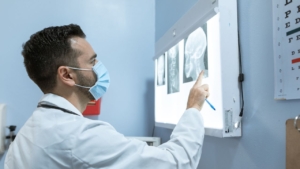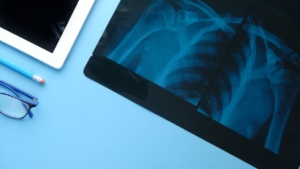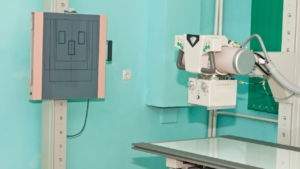Key Takeaways:
- Contrast Allergy Management: Pretreatment strategies are crucial for managing contrast allergies in high-risk patients, minimizing risks while ensuring diagnostic accuracy.
- Pretreatment Strategies: These include administering antihistamines, corticosteroids, and choosing low-osmolar contrast agents.
- Patient Safety: Prioritizing patient safety involves thorough screening, individualized protocols, and monitoring for adverse reactions.
- Technological Advancements: Ongoing advancements include developing safer contrast agents, utilizing AI tools, and improving premedication protocols.
- Radiology Safety Protocols: Implementing comprehensive screening, standardized procedures, and staff training is essential for minimizing risks and ensuring patient safety.
IV contrast allergy pretreatment is a critical tool in managing contrast allergies while ensuring the effectiveness of imaging procedures.
For patients with a history of contrast-induced allergic reactions, balancing the risks and the diagnostic necessity of contrast-enhanced imaging requires careful planning and adherence to radiology safety protocols.
By understanding the intricacies of contrast media safety, healthcare professionals can optimize outcomes and prioritize patient safety in contrast imaging.
The Importance of Pretreatment in IV Contrast Imaging
IV contrast allergy pretreatment helps mitigate the risks of iodinated contrast allergies without compromising the diagnostic benefits of contrast-enhanced imaging.
This approach is particularly important for patients with moderate to severe allergic histories.
Key benefits include:
- Reduced likelihood of contrast-induced allergic reactions, ensuring safer imaging procedures.
- Enhanced comfort and confidence for patients undergoing necessary diagnostics.
- Improved adherence to radiology safety protocols, promoting a culture of safety.
By implementing pretreatment strategies, healthcare teams can strike a balance between risk vs. necessity in imaging for sensitive patients.
Commonly Used Pretreatment Strategies
Pretreatment protocols involve administering medications before the imaging procedure to minimize allergic reactions. These strategies are tailored to individual patient needs.
Common pretreatment options include:
- Antihistamines: Reduce mild symptoms like itching and hives.
- Corticosteroids: Address moderate to severe allergic responses by suppressing the immune system.
- Intravenous fluids: Help maintain hydration and reduce the impact of potential reactions.
These approaches ensure patients receive the care they need while minimizing risks associated with iodinated contrast allergies.
Key Steps in IV Contrast Allergy Pretreatment
Developing a robust pretreatment protocol involves several essential steps that prioritize contrast media safety and patient safety in contrast imaging.
Steps include:
- Thorough patient screening to identify a history of contrast-induced allergic reactions.
- Administering appropriate premedication for contrast reactions based on the patient’s allergy profile.
- Selecting low-osmolar or iso-osmolar contrast agents to reduce the risk of allergic responses.
- Monitoring the patient closely during and after the procedure to address any adverse events promptly.
These steps ensure comprehensive protection and confidence for both patients and healthcare providers.
Risk Vs. Necessity in Imaging: A Delicate Balance
For many patients, the diagnostic benefits of contrast-enhanced imaging far outweigh the risks.
However, managing contrast allergies effectively requires a balanced approach that prioritizes contrast media safety while ensuring diagnostic accuracy.
Considerations include:
- Evaluating the urgency and necessity of contrast-enhanced imaging for the patient’s condition.
- Weighing alternatives, such as non-contrast imaging techniques, when appropriate.
- Adhering to radiology safety protocols to minimize risks in high-risk cases.
This balanced approach ensures healthcare providers can deliver critical diagnostic information while maintaining patient safety in contrast imaging.
Address Adverse Reactions in High-Risk Patients
For high-risk patients, managing adverse reactions to contrast agents is a critical component of diagnostic imaging. Reactions can range from moderate reactions, such as mild rashes or discomfort, to severe reactions like anaphylaxis.
Key considerations for high-risk patients include:
- Using gadolinium-based contrast agents for magnetic resonance imaging when iodinated contrast media poses a higher risk.
- Administering lower radiation doses during contrast-enhanced CT procedures to minimize potential harm.
- Developing individualized protocols to ensure both effective diagnostics and optimal patient care.
By taking these precautions, health care providers can ensure safer imaging experiences for patients at greater risk.
The Role of Gadolinium-Based Contrast Media in MRI
Magnetic resonance imaging often relies on gadolinium-based contrast media to enhance the clarity of soft tissue structures.
This makes it indispensable for diagnosing complex conditions while balancing potential risks for patients at risk.
Advantages of gadolinium-based contrast agents include:
- Superior visualization of blood vessels, tumors, and other abnormalities.
- Reduced risk of severe allergic reactions compared to iodinated agents.
- Essential support for medical imaging procedures requiring detailed soft tissue contrast.
With proper protocols, gadolinium agents offer a safe and effective solution for medical imaging exams.
Enhance Patient Care with Tailored Imaging Protocols
Tailored imaging protocols ensure that medical imaging procedures address the unique needs of each patient while minimizing risks. Health care providers can optimize safety and outcomes by adapting protocols based on patient history and clinical requirements.
Core elements of tailored imaging protocols include:
- Comprehensive pre-procedure assessments to identify patients at risk of adverse reactions.
- Adjusting contrast agent types and dosages based on individual risk factors.
- Implementing post-procedure monitoring to quickly address any delayed moderate reactions or other issues.
This personalized approach improves patient care and enhances the efficacy of diagnostic imaging.
Implement Radiology Safety Protocols for Enhanced Imaging
Radiology safety protocols are essential for reducing contrast-induced allergic reactions and ensuring patient safety in contrast imaging. These protocols provide structured guidelines to manage potential risks and improve diagnostic outcomes.
Key elements of effective safety protocols include:
- Comprehensive screening processes to identify patients with a history of allergies or other risk factors.
- Detailed premedication plans to mitigate the likelihood of contrast-induced allergic reactions.
- Real-time monitoring during imaging procedures to promptly address any adverse events.
- Ongoing staff training to ensure the proper application of safety measures and emergency responses.
By adhering to these protocols, healthcare providers can safeguard patients while maintaining the precision and reliability of modern diagnostic imaging.
Advances in Allergy Prevention in IV Imaging
Recent advancements have improved allergy prevention in IV imaging, providing safer options for patients with known sensitivities.
Key innovations include:
- Development of contrast agents with lower allergenic potential, enhancing contrast media safety.
- Enhanced protocols for premedication for contrast reactions, improving their efficacy in reducing allergic responses.
- Use of AI tools to predict patient risk based on medical history and previous reactions.
These advancements empower radiologists and healthcare teams to manage risks effectively while ensuring accurate diagnostics.
Prioritize Safety with Spectrum Medical Imaging Co.’s Expert Solutions
Ensure superior patient safety in contrast imaging by adopting robust radiology safety protocols and advanced contrast solutions.
Spectrum Medical Imaging Co. offers the expertise and tools you need to manage contrast-induced allergic reactions effectively and deliver safe, accurate diagnostics.
Call us today at 800-859-6162 to learn more about our comprehensive imaging solutions!




